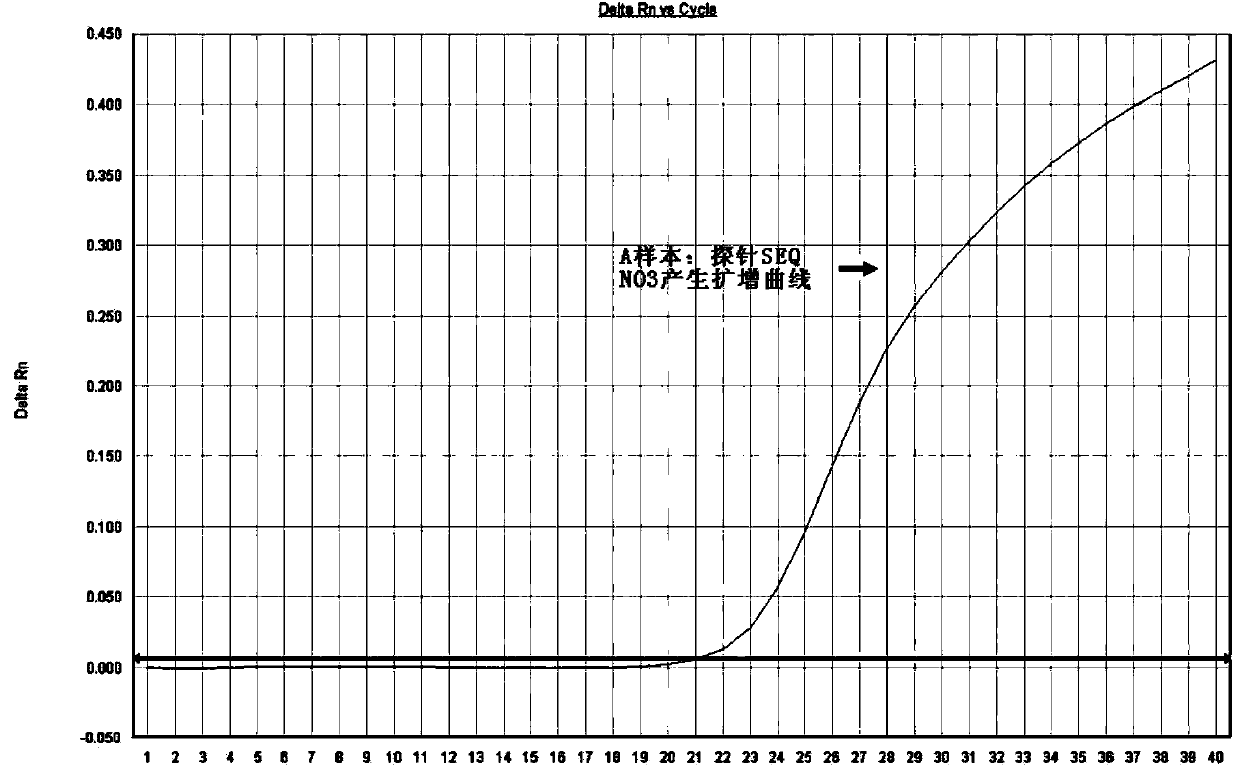Method for detecting mutation on locus deltaF508 of CFTR (Cystic Fibrosis Transmembrane Regulator) gene and oligonucleotide
An oligonucleotide and site mutation technology is applied in the field of oligonucleotides for highly sensitive detection of CFTR gene ΔF508 site mutations, which can solve the problems of complex labeling process, false positives, and poor specificity, and reduce costs. The interference of the bottom signal, good accuracy and specificity, and the effect of improving the detection sensitivity
- Summary
- Abstract
- Description
- Claims
- Application Information
AI Technical Summary
Problems solved by technology
Method used
Image
Examples
Embodiment 1
[0050] An oligonucleotide for detecting the mutation of the CFTR gene ΔF508 site in a sample, the oligonucleotide comprising:
[0051] (1) A pair of specific amplification products SEQ NO1 and SEQ NO2, the base sequence of which is:
[0052] SEQ NO 1: TGGAGCCTTCAGAGGGTAAA
[0053] SEQ NO2: TGGGTAGTGTGAAGGGTTCAT
[0054] (2) A pair of specific detection probes SEQ NO3 and SEQ NO4, the base sequence of which is:
[0055] SEQ NO 3: FAM-AGAAAATATCATCTTTGGTGTT-MGB
[0056] SEQ NO4: HEX-AGAAAATATCATCGGTGTTTCCT-MGB
[0057] Among them, MGB is marked at the 3' end of SEQ NO3 and SEQ NO4 to enhance detection specificity.
[0058] A kit for detecting the ΔF508 point mutation of the CFTR gene in a sample, the kit including a sample DNA extraction reagent, erythrocyte lysate, absolute ethanol, qPCR amplification reaction solution, a positive control substance, a negative control substance and a blank control products, as follows:
[0059] 10× red blood cell lysate formula: NH 4 Cl8...
Embodiment 2
[0068] Embodiment 2: detection process
[0069] (1) Blood DNA extraction: Take 500ul whole blood, put it into a 1.5ml centrifuge tube, add 1ml red blood cell lysate. Turn it upside down to make it completely mixed, rotate and pulsate for 15 seconds, and then put it into a centrifuge for centrifugation at 5000rpm for 10min. Pour off the upper layer, and it can be seen that there is a bloody precipitate at the bottom of the centrifuge tube. Add 500ul red blood cell lysate, repeat this lysis step once. Centrifuge at 5000rpm for 5min, and finally suck up all the upper layer with a pipette and discard it, so that the blood-colored precipitate at the bottom of the centrifuge tube no longer has lysate. Mix well with a metal bath at 100°C for 10 minutes, 12000 rpm for 5 minutes, take the supernatant, and obtain the sample DNA solution. When not used immediately, the sample DNA solution was stored at -20°C until use.
[0070] (2) Real-time fluorescent PCR amplification:
[0071] T...
Embodiment 3
[0075] Embodiment 3: Sample detection verification
[0076] 5 clinical samples were selected, numbered 1-5, among which sample No. 1 was a male infertility patient suspected of having the CFTR gene ΔF508 mutation, and samples No. 2-5 were physical examination samples, which were not infertile patients. The implementation steps are as follows:
[0077] (1) Samples 1-5 are peripheral blood, and DNA is extracted according to the blood DNA extraction method described in Example 2.
[0078] (2) According to the real-time fluorescent PCR amplification method described in Example 2, real-time fluorescent PCR (qPCR) detection was carried out to the DNA of No. 1-5 samples, and Sanger sequencing analysis was carried out to the 10th exon of the CFTR gene of these 5 samples at the same time and PCR-SSCP electrophoresis analysis, wherein the PCR-SSCP electrophoresis graph is as follows Figure 8 shown. The results of the three methods are shown in the table below:
[0079]
[0080] ...
PUM
 Login to View More
Login to View More Abstract
Description
Claims
Application Information
 Login to View More
Login to View More - R&D
- Intellectual Property
- Life Sciences
- Materials
- Tech Scout
- Unparalleled Data Quality
- Higher Quality Content
- 60% Fewer Hallucinations
Browse by: Latest US Patents, China's latest patents, Technical Efficacy Thesaurus, Application Domain, Technology Topic, Popular Technical Reports.
© 2025 PatSnap. All rights reserved.Legal|Privacy policy|Modern Slavery Act Transparency Statement|Sitemap|About US| Contact US: help@patsnap.com



